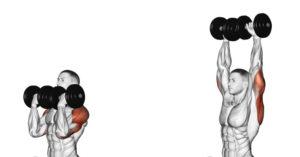
Synonyms
The standing dumbbell over-the-neck press is also known as the Dumbell military press, Dumbell shoulder press.
Type of Exercise
Standing Dumbbell Above-the-Neck Stretch is a Multiarticular / Accessory Exercise
variants
- Above-the-nape presses with seated dumbbells
Above-the-nape presses with standing dumbbells: Execution
The starting position sees the athlete standing upright, but with the torso and head tilted slightly back, with the back in its position of strength and the knees slightly flexed. The distance between the feet (stride) is equal to or slightly more than the distance between the shoulders. The elbows are flexed, the wrists straight and the shoulders are not completely abducted in the transverse plane, but are adducted in the longitudinal plane and extra-rotated so that the elbow, wrist and handlebar grip are aligned in all three planes. The dumbbells are held at the same height as the upper part of the sternum with a grip that can be prone or neutral; the latter is more correct and particularly recommended when the handlebars are bulky, which therefore if held with a prone grip, would force the athlete to keep the elbows less flexed than it would take to have the forearms perpendicular to the ground with consequent unnecessary effort on the part of the elbow flexors to hold the handlebars and reduce the descent movement. The execution consists of pushing the dumbbells up on the vertical plane they were on before starting, thus trying to draw a segment of a straight line and not a curve. During the push, the shoulders flex in the sagittal plane and abduct in the longitudinal plane, while the elbows extend and the shoulder blades begin to rotate upward when the elbows are at or above shoulder level. The execution ends with the full extension of the elbows and just before the arms come to be perpendicular to the ground. It is also possible to perform this exercise in a unilateral version with consequent greater stimulation of the stabilizers of the spine. The use of knee and / or hip extensions to help raise the bar is considered cheating, but it is allowed to maintain balance . Performing this exercise requires some shoulder mobility if it is not kept fully abducted in the transverse plane, while good shoulder mobility is required to keep it fully abducted in the transverse plane.
Muscles involved in the exercise Above-the-neck presses with standing dumbbells
Group 0
- Lateral deltoid
- Anterior deltoid
- Upper bundles of the pectoralis major
- Supraspinatus
- Coracobrachiale
- Brachial biceps
Shoulder abduction
Group 1
- Triceps bracelet
- Anconeus
- Common extensor of the fingers
- Extensor radial carpus
- Extensor carpus ulnar
Elbow extension
Group 2
- Inferior bundles of the great dentate thoracic
- Lower bundles of the trapezius
- Intermediate beams of the trapezius
Upper scapular rotation


























